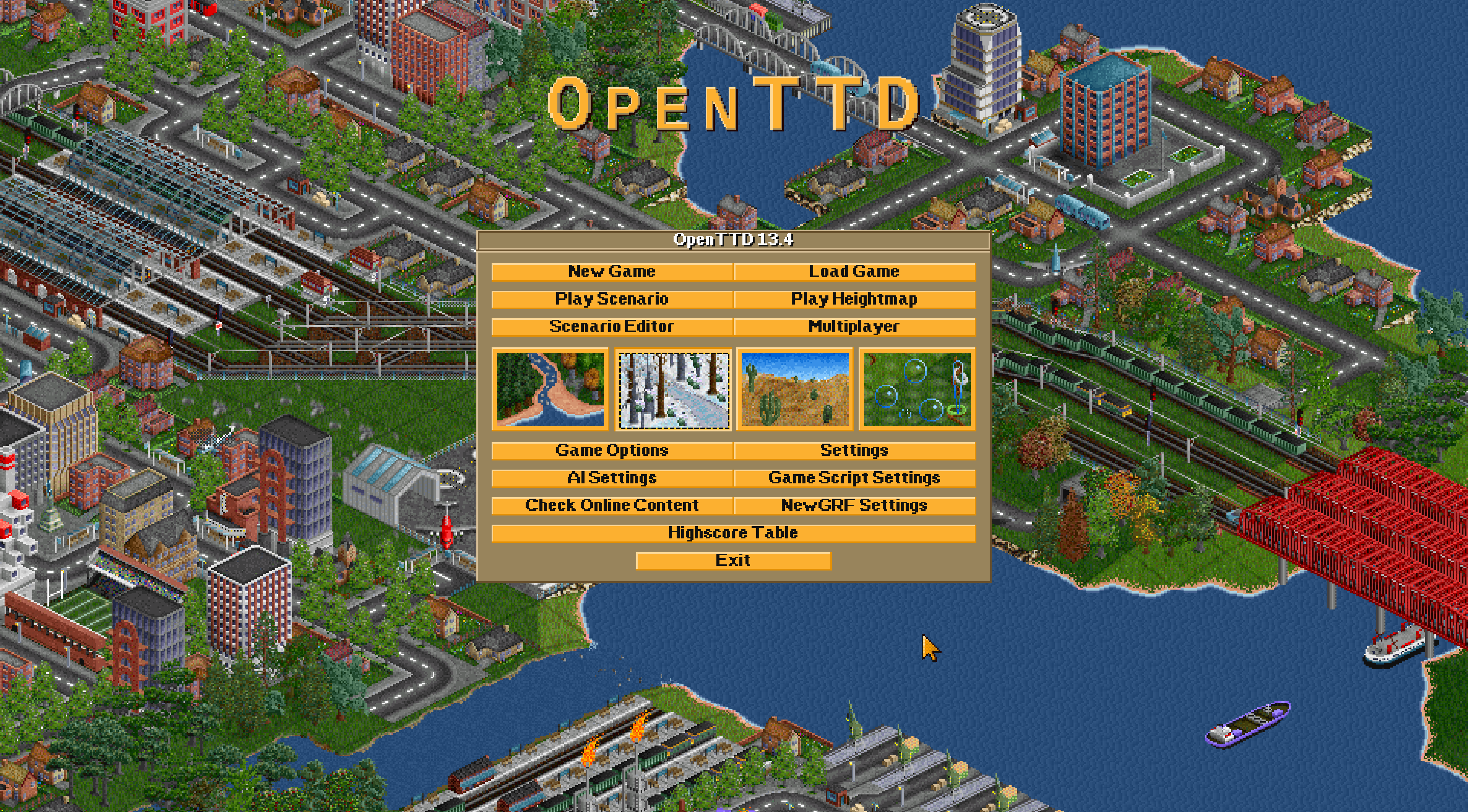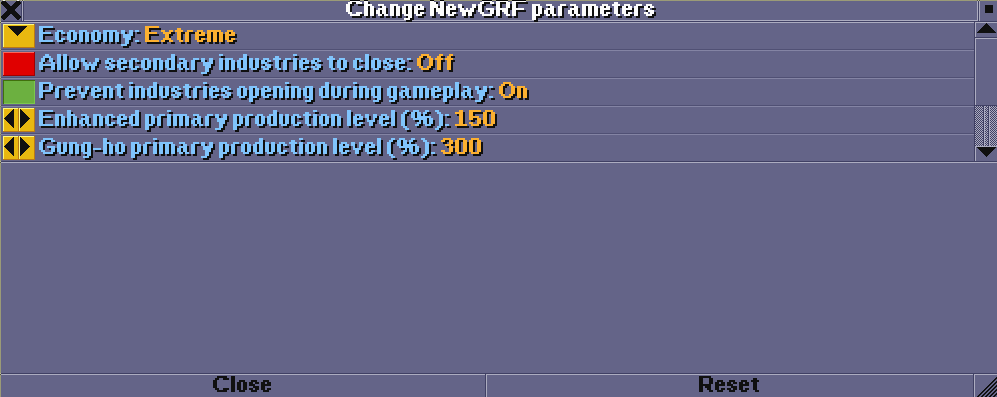OpenTTD

OpenTTD is an open source clone of the Transport Tycoon series of transport business simulation games. This game has tremendous depth and replayability thanks to decades of open source development. While it’s a lot of fun to play, especially multiplayer, the default gameplay quickly becomes old or stale to experienced players:
- There’s a runaway effect where if you accumulate enough wealth, it’s almost impossible to lose. The game quickly degrades into a painting game where you can run transportation networks virtually anywhere without penalty.
- The variety of industries is low, making it easy to connect all available industries in a short amount of time. There are only so many times you can transport the same type of cargo over and over before boredom sets in.
- Industries disappear if you don’t transport cargo to them within a few years, leaving the map an empty wasteland instead of a puzzle of industries waiting to be serviced.
- Towns grow too easily, and the snowball effect of delivering more passengers and mail to grow them (which in turn generates more passengers and mail) is more powerful than any freight combination.
- Rail upgrades are tedious when monorail and maglev become available. To upgrade from one type to another, you need to move all existing trains to a depot, sell them all, upgrade the tracks, then create all new trains of the new type. That’s not realistic, and it’s not fun.
- Passengers are just cargo and don’t feel like a unique part of the rail network.
The authors of OpenTTD have done a great job of allowing the game to be expanded and modified through the use of NewGRF sets. NewGRF sets are easy to explore, download, and install directly from OpenTTD’s main menu. These sets can be cosmetic or alter gameplay (or both). I’ll be focusing on some NewGRF sets that I think make the gameplay more challenging and interesting.
The Runaway Effect#
In my experience, the difficulty setting in OpenTTD doesn’t actually make the game significantly more difficult. There are two options hidden in the Accounting Settings that have a much greater impact:

- Inflation is the biggest one, which causes both expenses and income to inflate over time. The difficulty comes in the fact that expenses will inflate at a faster rate than income, which significantly throttles your ability to expand.
Unfortunately, as of this writing, the Iron Horse NewGRF (discussed below) is incompatible with inflation. If you use Iron Horse, you’ll need to turn inflation off.
- Infrastructure Maintenance is the other, but less significant, difficulty option. It charges you a monthly fee at the beginning of the month for various infrastructure tiles (stations, signals, etc.) This penalizes “painting” and low-utilization builds and encourages efficiency.
With all of these turned on (as well as setting running costs and construction costs to “high”), it’s very easy to bankrupt yourself, even in the late game.
Industry Variety#
FIRS is a complete industry replacement NewGRF set that’s been in development for over a decade. The developers have carefully planned out complex economies that make for interesting, dynamic gameplay. For example, you might want to start with a company that specializes in transporting oil products, or metal cargoes. These sub-economies are individually more complex than the default OpenTTD economy.
 (Visit the FIRS website here to browse the different economy cargo flow diagrams in better detail.)
(Visit the FIRS website here to browse the different economy cargo flow diagrams in better detail.)
What makes FIRS stand out from the default OpenTTD economy (aside from its complexity) is that a lot of it feeds back on itself. For example, in the economy above, the more materials you deliver to the port, the more engineering supplies the port will produce. When you deliver these engineering supplies back to an accepting industry (like a copper mine), the mine will then produce more of its raw resource. This in turn will generate more resources to deliver to the port, and so the cycle continues.
Prevent Industries from Disappearing#
FIRS also allows you to manipulate how industries open or close. Changing “Allow secondary industries to close” to “off” fixes the ‘industries disappear’ problem. Now all industries on the map at generation time will remain there until the end of the game, presenting an interesting puzzle to be solved over time instead of a race against the clock to supply industries before they disappear.

I never understood why disappearing industries is the default behaviour in OpenTTD, but I think interacting with an empty map in the mid-to-late game is very boring.
Town Growth#

Growing towns is a lot more challenging and interesting after installing Renewed Village Growth. Transporting passengers and mail to or from the town will kick off growth, but to keep the ball rolling you need to deliver a variety of resources over the town’s life. For example, in the early game the town might demand fruit, livestock, or grain before it resumes growth. In the late game, as the town becomes a metropolis, it will start demanding more complex resources such as engineering supplies, goods, or building materials.
Rail Upgrades#

The Iron Horse NewGRF is a train set that completely eliminates monorail and maglev vehicles available in stock OpenTTD. This is a good thing. It means that from the start of the game to the end, most cargo runs on regular railway tracks, and there’s no need to upgrade to monorail or maglev. The only noteable track upgrade is for electrification, which can be done in-place without the tedious “destroy and replace” upgrade process necessary in stock OpenTTD.
Another big difference between Iron Horse and the default gameplay is that carriages have speed limits. For example, passengers and mail (and other “express” cargoes) can be transported faster than raw materials. This makes for interesting interactions in your network.
There are a lot of different locomotives available in Iron Horse, which can feel a little overwhelming, but it goes a long way to add to the challenge and flavour of the game. Iron Horse is inspired by British locomotives and it’s obvious that the author is passionate about it.
Making Passengers Feel Special#

FIRS is an industry-focused NewGRF, so it mostly concerns itself with the transportation of industrial cargoes. Passengers are just another type of cargo. This leaves the door open to add in a few more NewGRF sets that highlight passengers and passenger-specific modes of travel:
-
Iron Horse (as discussed above) provides a handful of high-capacity Metro vehicles. These are good for transporting passengers short distances in dense metroplexes.
-
Road Hog provides trams that are useful for transporting passengers within a town, even small towns. You can lay the tram tracks down on top of roads, which makes it possible to use the town’s existing road network. This NewGRF has a bunch of regular road vehicles as well.
-
Real International Maglev Set provides high speed rail vehicles based on the real world. This is where you’ll find Germany’s Transrapid, Japan’s L0 Shinkansen, and so on. However, these vehicles are so fast that it skews the payouts so that it doesn’t make sense to build anything but these once they’re available. They look great, but the “Dedicated High Speed Rail” in Iron Horse is much more balanced.
-
Aviators Aircraft Set (sometimes called just “av8”) is for the aircraft lovers, from Zeppelins to futuristic sub-orbiters.

In the real world, passenger rail (commuter rail, subways, or LRT’s) often has segregation from heavy freight networks. There’s no reason why OpenTTD should be any different. These NewGRF sets add the ability to construct unique passenger networks with distinctly different properties from regular FIRS rail. Since FIRS doesn’t concern itself much with moving passengers around, these sets fit the missing piece of the puzzle very well.
Since FIRS combined with Iron Horse don’t provide monorail or maglev, there’s no need to upgrade your freight network from regular rail (be it steam, electric, or diesel.) Regular, “heavy” rail will remain in use throughout the game from beginning to end as a core part of gameplay, which wasn’t true in stock OpenTTD.
In the early game, simple tram stations stimulate city growth. In the late game, only high speed rail can achieve the highest speeds (up to 600kph), but since high speed rail can only transport passengers or mail, it can’t be abused like in stock OpenTTD to transport lucrative industrial cargoes. This makes for much more interesting gameplay with a great amount of variety. It also eliminates the need to tediously upgrade your freight network from standard rail to maglev or monorail, and creates realistic passenger networks.
These late-game high speed passenger rail networks take on a look similar to Taiwan’s High Speed Rail, or Japan’s Shinkansen network.
Go Play!#
With all of these modifications, OpenTTD is transformed into a long-running, complex simulation with high difficulty and strong variation between games. It remains interesting throughout as key milestones are reached. I like to start at 1860 and end at 2060 to allow plenty of time to develop:
- 1860: Game begins with steam locomotives, simple road vehicles and trams.
- 1900: Metro becomes available, high-density passenger transport over short distances.
- 1919: Electric trains available, seamless upgrade of existing freight rail network to electric.
- 1954: Diesel trains available.
- 1984: High Speed Rail begins to unlock.
- 2060: Game over.
The end result is a complex freight network that covers the entire map, densely built cities with tight metro/tram systems, and long lines of high speed passenger railways.
As of this writing, here are the exact versions of each NewGRF set used. There are a lot of cosmetic-only NewGRF sets here that weren’t discussed above, and they go a long way to add a lot of flavour to the game. Enjoy!
